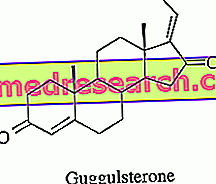The term dyspepsia is of Greek origin (dys-pepto) and means "difficult digestion".

There are various forms of dyspepsia, which can be differentiated based on the predominant symptoms and the triggering cause.
The symptom picture can be variable, but it is always characterized by a sensation of digestive difficulty.
The causes are to be found in:
- Altered gastric adaptation to food intake.
- Delayed gastric emptying.
- Visceral hypersensitivity.
- Altered motility of small intestine.
- Alteration of motor nervous control.
What to do
- Identify the main symptoms, which must be present at least 6 months and consistently in the last 3:
- Epigastric pain.
- Postprandial filling.
- Early satiety.
- Nausea.
- He retched.
- Belching.
- Consult a primary care physician or a gastroenterologist who will carry out the specific diagnosis.
- Based on the symptomatic picture, dyspepsia can be defined:
- Postprandial.
- Painful epigastric.
- Depending on the causes, however, dyspepsia can be defined:
- Organic dyspepsia : secondary to diseases of the digestive tract or extra digestive tract. The triggers can be different:
- Digestive disorders:
- Gastroesophageal reflux disease (GERD): the remedy consists of a specific diet, associated with lifestyle changes. In addition, certain medications are recommended.
- Esophageal neoplasms: surgery is required.
- Peptic ulcer: dietary therapy, a change in lifestyle, drug administration and sometimes surgery is required.
- Gastric neoplasms: surgery is required.
- Biliary lithiasis: a specific dietary pattern, pharmacological administration and sometimes surgery are required.
- Pancreatopathies: the remedy varies according to the causative agent.
- Extradigestive disorders (we will not mention the specific remedy since it is outside the scope of the article):
- Endocrinopathies.
- Congestive heart failure.
- Kidney failure.
- Collagen.
- Vasculitis.
- Digestive disorders:
- Functional dyspepsia : recognizable due to the absence of organic problems (digestive or systemic). The cause could be a motor dysfunction caused by the loss of nitrergic neurons in the stomach wall (sensory and motor).
- Organic dyspepsia : secondary to diseases of the digestive tract or extra digestive tract. The triggers can be different:
NB : Organic dyspepsia has a high percentage of comorbidity due to Helicobacter pylori infection. However, there is no scientific evidence that it can be responsible for dyspepsia alone.
What NOT to do
- Ignore the symptoms: since the dyspepsia can be caused by serious pathologies, ignoring the symptoms can lead to a worsening of health.
- Do not seek medical attention.
- Follow a diet and lifestyle that worsens digestion and symptoms.
- After diagnosis, do not comply with specific therapy.
What to eat
Dyspepsia diet is a very important factor, but general advice is not very specific; in case of comorbidity it is necessary to respect the precise rules of the pathology:
- Chew thoroughly.
- Do not drink excessively during meals and do not eat "dry": 1-2 glasses per meal are sufficient.
- Regularize meals.
- Divide the diet into at least 5-6 meals a day, of which the most abundant must be lunch. For example: 15% of calories at breakfast, 3 snacks at 10%, lunch at 30% and dinner at 25%.
- Share calories in a balanced way; the ration of fats is of particular importance, and should be taken in proportions equal to 25% of the calories consumed. It is sufficient to consume partially or totally skimmed milk / yogurt, very few cheeses, meats and lean fish, a couple of whole eggs a week, no more than 10g of dried fruit a day and to season each dish with only 1 teaspoon of oil.
- Choose portions and meals of appropriate size: for example, no more than 80g of pasta or pulses, no more than two slices of bread per meal, no more than 150g of meat or fish, no more than two eggs at a time (cooked without fats) etc.
- Except for nighttime sleep, let no more than 3 hours pass between meals.
- Prefer light cooking methods: boiling, steaming, vacuum cooking, vasocottura etc.
What NOT to Eat
- Avoid large meals.
- Avoid large portions.
- Avoid fasting.
- Avoid eating before going to bed or eating excessively before standing still (lying down or sitting).
- Many diagnoses of dyspepsia are complicated by a food intolerance or allergy. The first rule is to eliminate all the factors responsible for adverse reactions; the most frequent are lactose (lactose intolerance) and gluten (celiac disease).
- Especially in ulcerative-like painful dyspepsia, it is necessary to eliminate:
- Irritating foods: chili pepper, pepper, excess of garlic and onion, ginger, horseradish, wasabi etc.
- Excess alcohol.
- Drinks and foods containing xanthines: coffee, tea (mainly fermented), cocoa, chocolate, energy drinks, etc.
- Acidic and / or carbonated beverages: cola, gaseous, orangeade etc.
- Especially in dyspepsia with dysmobility and a sense of postprandial filling, it is necessary to eliminate:
- Excessive seasoning, especially of little nutritional value: margarine, palm or plamisto oil, other hydrogenated or bifractionated vegetable oils, lard, fat from meat leaking etc.
- Fatty foods, especially of little nutritional value: mascarpone, cream, salami, fast food meat, fried food, snacks, sweets, etc.
- Avoid foods that interfere negatively with the trophism of the lower esophageal sphincter: for example, mint, cocoa, etc.
- Avoid heavy cooking methods: frying, stewing etc.
Natural Cures and Remedies
Like the other therapies, they are extremely specific. Below we will list the most used ones:
- For dyspepsia caused by gastroesophageal reflux disease:
- Alkaloids with anticholinergic action that reduce gastric secretion:
- Atropine and scopolamine: contained in the leaves of Atropa belladonna. WARNING! Use is no longer recommended due to potential side effects; moreover, the berries of the same plant are strongly poisonous.
- Mucilaginous drugs that protect the mucous membrane of the stomach and esophagus:
- Altea, alginic acid, mallow, island lichen and aloe gel.
- For dyspepsia caused by gastritis and peptic ulcer:
- Sodium bicarbonate (NaHCO3): in aqueous solution, it intervenes quickly, but causes some side effects such as: alkalinization of the urine, swelling, hypersodemia and sometimes diarrhea.
- Herbalist: some plants are able to improve peptic ulcer symptoms or to act positively on the mechanism of action. The best known are:
- St. John's Wort.
- Licorice.
- Passiflora.
- Chamomile.
- Comfrey.
- Calendula.
- Alginates and mucilaginous drugs that cover the gastric mucosa, protecting it from aggressive agents:
- Melissa.
- Altea.
- Mauve.
- Icelandic lichen.
- Calendula.
- Mother tinctures with healing effect:
- salicaria
- Strawberry.
- Garlic: it can facilitate the eradication of Helicobacter pylori, but it stimulates gastric secretion and is contraindicated for ulcers (see Helicobacter pylori - Defeat it with Natural Remedies).
- Clove essential oil.
- For dyspepsia caused by biliary lithiasis disease:
- Milk thistle.
- Artichoke.
- Enula.
- Fennel.
- Aubergine.
- Borage.
- Peppermint.
- Absinthe.
- Oats.
- Cherry.
- Onion.
- Strawberry.
- Lemon.
- Grapes.
- Rhubarb.
- Boldo.
- Aloe.
- Chicory.
- Rosemary.
- Dandelion (controversial).
Pharmacological care
- For dyspepsia caused by gastroesophageal reflux disease and peptic ulcer:
- Histamine H2 receptor antagonists: ranitidine, cimetidine (eg Ulis, Biomag, Tagamet), famotidine and nizatidine (eg Nizax, Cronizat, Zanizal). For oral and rarely parenteral use, they inactivate the proton pump and reduce the release of hydrogen ions.
- Antacids (such as aluminum hydroxide with magnesium hydroxide, eg Maalox plus).
- Proton pump inhibitors: block the production of histamine, gastrin and acetyl choline; in association with antibiotics they favor the elimination of Helicobacter pylori. For example:
- Pantoprazole (such as Peptazol, Pantorc, Nolpaza, Gastroloc).
- Omeprazole (such as Antra, Nansem, Losec, Xantrazol).
- Lansoprazole (like Pergastid, Lomevel, Lansox).
- Protectors of the gastric mucosa:
- Sucralfate (eg Degastril, Citogel).
- Bismuth compounds (eg salicylate bismuth).
- Analogues of prostaglandins: they protect the mucosa thanks to the reduction of gastric secretion; for example Misoprostol (as Cytotec).
- Antibiotics against Helicobacter pylori:
- Amoxicillin: eg Augmentin, Klavux.
- Metronidazole: for example Metronid, Deflamon.
- Clarithromycin.
- For dyspepsia caused by biliary lithiasis:
- Ursodeoxycholic acid or ursodiol (eg Ursobil HT, Ursodes AGE acid, Litursol): they tend to dissolve small and transparent stones.
- Terpenes: make bile more soluble.
- Chenodeoxycholic acid: tends to dissolve stones.
- Thiazide diuretics (eg hydrochlorothiazide: eg Moduretic, Esidrex): useful against calcium aggregations.
Prevention
The prevention of dyspepsia, when possible, could be summarized as follows:
- Prevent or treat gastroesophageal reflux disease.
- Helps prevent the occurrence of esophageal neoplasms.
- Prevent or treat gastritis and peptic ulcer.
- Helps prevent the onset of gastric neoplasms.
- Preventing or treating biliary lithiasis.
- Prevent or treat pancreatopathies.
- Avoid the loss of gastric neurons: it is typical of serious gastric pathologies.
Medical Treatments
- In the case of cancer, surgery is aimed at removing the latter and the compromised tissues.
- For dyspepsia caused by gastroesophageal reflux disease:
- Intervention executable in laparoscopy (fundoplication), with the aim of restoring the functionality of the gastroesophageal sphincter.
- For dyspepsia caused by peptic ulcer:
- Excision of the gastric branches of the vagus nerve, with the aim of reducing gastric secretion.
- Gastrectomy: resection of a part of the stomach.
- For dyspepsia caused by biliary lithiasis:
- Traditional cholecystectomy: invasive; provides a significant surgical cut but has a very high success rate.
- Videolaparosurgery: minimally invasive; the cuts are small but it is limited when the gall bladder is hidden. In this case, the traditional method is used.



